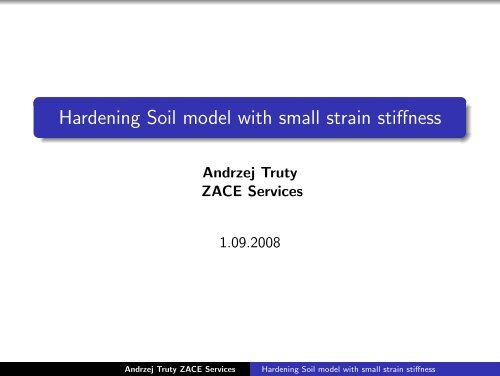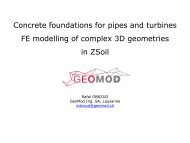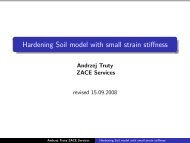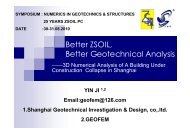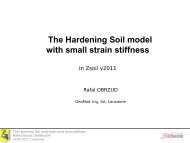Hardening Soil model with small strain stiffness - Zace Services Ltd.
Hardening Soil model with small strain stiffness - Zace Services Ltd.
Hardening Soil model with small strain stiffness - Zace Services Ltd.
Create successful ePaper yourself
Turn your PDF publications into a flip-book with our unique Google optimized e-Paper software.
<strong>Hardening</strong> <strong>Soil</strong> <strong>model</strong> <strong>with</strong> <strong>small</strong> <strong>strain</strong> <strong>stiffness</strong><br />
Andrzej Truty<br />
ZACE <strong>Services</strong><br />
1.09.2008<br />
Andrzej Truty ZACE <strong>Services</strong><br />
<strong>Hardening</strong> <strong>Soil</strong> <strong>model</strong> <strong>with</strong> <strong>small</strong> <strong>strain</strong> <strong>stiffness</strong>
Introduction<br />
<strong>Hardening</strong> <strong>Soil</strong> (HS) and <strong>Hardening</strong> <strong>Soil</strong>-<strong>small</strong> (HS-<strong>small</strong>)<br />
<strong>model</strong>s are designed to reproduce basic phenomena exhibited<br />
by soils:<br />
densification<br />
<strong>stiffness</strong> stress dependency<br />
plastic yielding<br />
dilatancy<br />
strong <strong>stiffness</strong> variation <strong>with</strong> growing shear <strong>strain</strong> amplitude<br />
in the regime of <strong>small</strong> <strong>strain</strong>s (γ = 10 −6 to γ = 10 −3 )<br />
this phenomenon plays a crucial role for <strong>model</strong>ing deep<br />
excavations and soil-structure interaction problems<br />
NB. This <strong>model</strong> is limited to monotonic loads<br />
Andrzej Truty ZACE <strong>Services</strong><br />
<strong>Hardening</strong> <strong>Soil</strong> <strong>model</strong> <strong>with</strong> <strong>small</strong> <strong>strain</strong> <strong>stiffness</strong>
Introduction<br />
HS <strong>model</strong> was initially formulated by Schanz, Vermeer and<br />
Bonnier (1998, 1999) and then enhanced by Benz (2006)<br />
Current implementation is slightly modified <strong>with</strong> respect to<br />
the theory given by Benz:<br />
simplified treatment of dilatancy for the <strong>small</strong> <strong>strain</strong> version<br />
(HS-<strong>small</strong>)<br />
modified hardening law for preconsolidation pressure<br />
This <strong>model</strong> seems to be one of the simplest in the class of<br />
<strong>model</strong>s designed to handle <strong>small</strong> <strong>strain</strong> <strong>stiffness</strong><br />
It consists of the two plastic mechanisms, shear and volumetric<br />
Small <strong>strain</strong> <strong>stiffness</strong> is incorporated by means of nonlinear<br />
elasticity which includes hysteretic effects<br />
Andrzej Truty ZACE <strong>Services</strong><br />
<strong>Hardening</strong> <strong>Soil</strong> <strong>model</strong> <strong>with</strong> <strong>small</strong> <strong>strain</strong> <strong>stiffness</strong>
Triaxial test: illustration<br />
Undrained triaxial test:<br />
Drained triaxial test :<br />
video<br />
video<br />
Annimations by P.Baran (University of Agriculture, Kraków,<br />
Poland)<br />
Andrzej Truty ZACE <strong>Services</strong><br />
<strong>Hardening</strong> <strong>Soil</strong> <strong>model</strong> <strong>with</strong> <strong>small</strong> <strong>strain</strong> <strong>stiffness</strong>
Notion of tangent and secant <strong>stiffness</strong> moduli<br />
Initial <strong>stiffness</strong> modulus E o<br />
Unloading-reloading modulus E ur<br />
Secant <strong>stiffness</strong> modulus at 50 % of the ultimate deviatoric<br />
stress q f<br />
0<br />
250<br />
q [kpa]<br />
200<br />
150<br />
100<br />
50<br />
1<br />
E o<br />
1 E 50<br />
q 50<br />
E ur<br />
1<br />
q f<br />
0.5 q f<br />
σ 3 =const<br />
q un<br />
0 0.05 0.1 0.15 0.2 0.25<br />
EPS-1 [-]<br />
Remark: All classical soil <strong>model</strong>s require specification of E ur<br />
modulus (Cam-Clay, Cap etc..)<br />
Andrzej Truty ZACE <strong>Services</strong><br />
<strong>Hardening</strong> <strong>Soil</strong> <strong>model</strong> <strong>with</strong> <strong>small</strong> <strong>strain</strong> <strong>stiffness</strong>
Stiffness-<strong>strain</strong> relation for soils (G/G o (γ))<br />
G - current secant shear modulus<br />
G o - shear modulus for very <strong>small</strong> <strong>strain</strong>s<br />
Atkinson 1991<br />
Andrzej Truty ZACE <strong>Services</strong><br />
<strong>Hardening</strong> <strong>Soil</strong> <strong>model</strong> <strong>with</strong> <strong>small</strong> <strong>strain</strong> <strong>stiffness</strong>
Notion of treshold shear <strong>strain</strong> γ 07<br />
G<br />
To describe the shape of (γ) curve an additional<br />
G o<br />
characteristic point is needed<br />
It is common to specify the shear <strong>strain</strong> γ 0.7 at which ratio<br />
G<br />
G o<br />
= 0.7<br />
0.7<br />
γ 07<br />
Andrzej Truty ZACE <strong>Services</strong><br />
<strong>Hardening</strong> <strong>Soil</strong> <strong>model</strong> <strong>with</strong> <strong>small</strong> <strong>strain</strong> <strong>stiffness</strong>
Dynamic vs static modulus<br />
Relation between ”static” Young modulus E s , obtained from<br />
standard triaxial test at axial <strong>strain</strong> ε 1 ≈ 10 −3 , and ”dynamic”<br />
Young modulus (the one at very <strong>small</strong> <strong>strain</strong>s) E d = E o is<br />
shown in diagram published by Alpan (1970) (after Benz)<br />
100<br />
E<br />
E<br />
d<br />
s<br />
Rocks<br />
10<br />
cohesive soils<br />
granular soils<br />
E s<br />
[kPa]<br />
1<br />
1000 10000 100000 1000000<br />
Andrzej Truty ZACE <strong>Services</strong><br />
<strong>Hardening</strong> <strong>Soil</strong> <strong>model</strong> <strong>with</strong> <strong>small</strong> <strong>strain</strong> <strong>stiffness</strong>
HS <strong>model</strong>: general concept<br />
Double hardening elasto-plastic <strong>model</strong> (Schanz, Vermeer,<br />
Benz)<br />
Nonlinear elasticity for stress paths penetrating the interior of<br />
the elastic domain<br />
600<br />
q [kPa]<br />
500<br />
400<br />
300<br />
200<br />
Cap surface<br />
100<br />
0<br />
0 100 200 300 400 500<br />
p [kPa]<br />
Graphical representation of shear mechanism and cap surface<br />
Andrzej Truty ZACE <strong>Services</strong> <strong>Hardening</strong> <strong>Soil</strong> <strong>model</strong> <strong>with</strong> <strong>small</strong> <strong>strain</strong> <strong>stiffness</strong>
HS <strong>model</strong>: shear mechanism<br />
Duncan-Chang <strong>model</strong> as the origin for shear mechanism<br />
250<br />
q f<br />
q [kPa]<br />
200<br />
150<br />
100<br />
50<br />
0<br />
E 50<br />
½ q f<br />
1<br />
1<br />
M-C limit<br />
0 0.01 0.02 0.03 0.04 0.05<br />
eps-1<br />
E ur<br />
Andrzej Truty ZACE <strong>Services</strong><br />
<strong>Hardening</strong> <strong>Soil</strong> <strong>model</strong> <strong>with</strong> <strong>small</strong> <strong>strain</strong> <strong>stiffness</strong>
Stiffness stress dependency<br />
Remarks<br />
E ur = E ref<br />
ur<br />
E 50 = E ref<br />
50<br />
( σ<br />
∗<br />
3 + c cotφ<br />
σ ref + c cotφ<br />
( σ<br />
∗<br />
3 + c cotφ<br />
σ ref + c cotφ<br />
) m<br />
) m<br />
1 Stiffness degrades <strong>with</strong> decreasing σ 3 up to σ 3 = σ L (by<br />
default we assume σ L =10 kPa)<br />
Andrzej Truty ZACE <strong>Services</strong><br />
<strong>Hardening</strong> <strong>Soil</strong> <strong>model</strong> <strong>with</strong> <strong>small</strong> <strong>strain</strong> <strong>stiffness</strong>
Extension to <strong>small</strong> <strong>strain</strong>: new ingredients<br />
To extend standard HS <strong>model</strong> to the range of <strong>small</strong> <strong>strain</strong> Benz<br />
introduced few modifications:<br />
1 Strain dependency is added to the stress-<strong>strain</strong> relation, for<br />
stress paths penetrating the elastic domain<br />
2 The modified Hardin-Drnevich relationship is used to relate<br />
current secant shear modulus G and equivalent monotonic<br />
shear <strong>strain</strong> γ hist<br />
3 Reversal points are detected <strong>with</strong> aid of deviatoric <strong>strain</strong><br />
history second order tensor H ij ; in addition the current<br />
equivalent shear <strong>strain</strong> γ hist is computed by using this tensor<br />
Andrzej Truty ZACE <strong>Services</strong><br />
<strong>Hardening</strong> <strong>Soil</strong> <strong>model</strong> <strong>with</strong> <strong>small</strong> <strong>strain</strong> <strong>stiffness</strong>
How does it work <br />
N-1<br />
N<br />
N+1<br />
plot from paper by Ishihara 1986<br />
At step N : γ histN−1 = 8 × 10 −5 γ histN = 10 −4<br />
At step N + 1 : γ histN = 0 γ histN+1 = 2 × 10 −5<br />
Primary loading: γ histN+1 > γhist<br />
max<br />
Unloading/reloading: γ histN+1 ≤ γ max<br />
Hardin-Drnevich law: G =<br />
hist<br />
G o<br />
1 + a γ hist<br />
γ 0.7<br />
(secant modulus)<br />
Andrzej Truty ZACE <strong>Services</strong><br />
<strong>Hardening</strong> <strong>Soil</strong> <strong>model</strong> <strong>with</strong> <strong>small</strong> <strong>strain</strong> <strong>stiffness</strong>
Shear tangent modulus cut-off<br />
G<br />
G ur<br />
γ c<br />
γ c = γ 0.7<br />
a<br />
Andrzej Truty ZACE <strong>Services</strong><br />
(√ )<br />
Go<br />
− 1<br />
G ur<br />
<strong>Hardening</strong> <strong>Soil</strong> <strong>model</strong> <strong>with</strong> <strong>small</strong> <strong>strain</strong> <strong>stiffness</strong><br />
γ
Setting initial state variables: γ PS<br />
o<br />
Given: σ o , OCR<br />
Find: γ PS<br />
and p co<br />
o and p co<br />
0<br />
600<br />
q [kPa]<br />
500<br />
400<br />
300<br />
200<br />
100<br />
Shear mechanism<br />
Cap surface<br />
σ ο<br />
σ SR<br />
0 100 200 300 400 500<br />
p [kPa]<br />
Procedure:<br />
Set effective stress state at the SR point<br />
σy<br />
SR = σ yo OCR<br />
σx<br />
SR = σz<br />
SR = σ y Ko<br />
SR<br />
Andrzej Truty ZACE <strong>Services</strong><br />
<strong>Hardening</strong> <strong>Soil</strong> <strong>model</strong> <strong>with</strong> <strong>small</strong> <strong>strain</strong> <strong>stiffness</strong>
Setting initial state variables: γ PS<br />
o<br />
and p co<br />
600<br />
q [kPa]<br />
500<br />
400<br />
300<br />
200<br />
100<br />
Shear mechanism<br />
Cap surface<br />
σ ο<br />
σ SR<br />
0<br />
0 100 200 300 400 500<br />
p [kPa]<br />
Procedure:<br />
For given σ SR state compute γo<br />
PS<br />
f 1 = 0<br />
from plastic condition<br />
For given σ SR state compute p co from plastic condition f 2 = 0<br />
Andrzej Truty ZACE <strong>Services</strong><br />
<strong>Hardening</strong> <strong>Soil</strong> <strong>model</strong> <strong>with</strong> <strong>small</strong> <strong>strain</strong> <strong>stiffness</strong>
Setting initial state variables: γ PS<br />
o<br />
and p co<br />
Remarks<br />
= Ko<br />
NC<br />
(approximate Jaky’s formula)<br />
1 K SR<br />
o<br />
2 K SR<br />
o<br />
≈ 1 − sin(φ) in the standard applications<br />
= 1 for case of isotropic consolidation (used in triaxial<br />
testing for instance)<br />
3 For sands notion of preconsolidation pressure is not as<br />
meaningful as for cohesive soils hence one may assume<br />
OCR=1 and effect of density will be embedded in H and M<br />
parameters<br />
Andrzej Truty ZACE <strong>Services</strong><br />
<strong>Hardening</strong> <strong>Soil</strong> <strong>model</strong> <strong>with</strong> <strong>small</strong> <strong>strain</strong> <strong>stiffness</strong>
Setting M and H parameters based on oedometric test<br />
600<br />
500<br />
σ<br />
q [kPa]<br />
400<br />
q*<br />
300<br />
200<br />
100<br />
p*<br />
0<br />
0 100 200 300 400 500<br />
p [kPa]<br />
σ ref 1<br />
oed<br />
E oed<br />
ε<br />
Andrzej Truty ZACE <strong>Services</strong><br />
<strong>Hardening</strong> <strong>Soil</strong> <strong>model</strong> <strong>with</strong> <strong>small</strong> <strong>strain</strong> <strong>stiffness</strong>
Material properties<br />
Parameter Unit HS-standard HS-<strong>small</strong><br />
Eur ref [kPa] yes yes<br />
E50 ref [kPa] yes yes<br />
σ ref [kPa] yes yes<br />
m [—] yes yes<br />
ν ur [—] yes yes<br />
R f [—] yes yes<br />
c [kPa] yes yes<br />
φ [ o ] yes yes<br />
ψ [ o ] yes yes<br />
e max [—] yes yes<br />
f t [kPa] yes yes<br />
D [—] yes yes<br />
M [—] yes yes<br />
H [kPa] yes yes<br />
OCR/q POP [—/kPa] yes yes<br />
Eo ref [kPa] no yes<br />
γ 0.7 [—] no yes<br />
Andrzej Truty ZACE <strong>Services</strong><br />
<strong>Hardening</strong> <strong>Soil</strong> <strong>model</strong> <strong>with</strong> <strong>small</strong> <strong>strain</strong> <strong>stiffness</strong>
Converting MC to HS <strong>model</strong>: indentation problem<br />
Assumption: q = 0.5 q ult<br />
Given: E for MC <strong>model</strong> and E ur<br />
E 50<br />
= ...,<br />
E 50<br />
E oed<br />
= ...<br />
1m<br />
A<br />
q = 0.5 q ult<br />
10m<br />
10m<br />
Find: E ref<br />
ur , M and H for standard HS <strong>model</strong><br />
Andrzej Truty ZACE <strong>Services</strong><br />
<strong>Hardening</strong> <strong>Soil</strong> <strong>model</strong> <strong>with</strong> <strong>small</strong> <strong>strain</strong> <strong>stiffness</strong>
Example: triaxial test on dense Hostun sand<br />
6<br />
5.5<br />
5<br />
120000<br />
SIG-1 / SIG-3 [kPa]<br />
4.5<br />
4<br />
3.5<br />
3<br />
2.5<br />
HS-std<br />
HS-<strong>small</strong><br />
G [kPa]<br />
100000<br />
80000<br />
60000<br />
40000<br />
HS-std<br />
HS-<strong>small</strong><br />
2<br />
1.5<br />
20000<br />
1<br />
0<br />
0 0.02 0.04 0.06 0.08 0.1<br />
0.00001 0.0001 0.001 0.01 0.1 1<br />
-EPS-Y [-]<br />
EPS-X - EPS-Y [-]<br />
(a) σ 1<br />
σ 3<br />
(ε 1 ) (Z <strong>Soil</strong>)<br />
(b) G(γ) (Z <strong>Soil</strong>)<br />
4<br />
3.5<br />
0 0.02 0.04 0.06 0.08 0.1<br />
0.08<br />
SIG-1 / SIG-3 [kPa]<br />
3<br />
2.5<br />
2<br />
HS-std<br />
HS-<strong>small</strong><br />
-EPS-V [-]<br />
0.07<br />
0.06<br />
0.05<br />
0.04<br />
0.03<br />
0.02<br />
HS-std<br />
HS-<strong>small</strong><br />
1.5<br />
0.01<br />
0<br />
1<br />
-0.01<br />
0 0.002 0.004 0.006 0.008 0.01<br />
-EPS-Y [-]<br />
-0.02<br />
-EPS-Y [-]<br />
(c) σ 1<br />
σ 3<br />
(ε 1 ) (zoom) (Z <strong>Soil</strong>)<br />
(d) ε v (ε 1 ) (Z <strong>Soil</strong>)<br />
Andrzej Truty ZACE <strong>Services</strong><br />
<strong>Hardening</strong> <strong>Soil</strong> <strong>model</strong> <strong>with</strong> <strong>small</strong> <strong>strain</strong> <strong>stiffness</strong>
Example: triaxial test on dense Hostun sand<br />
SIG-1 / SIG-3 [kPa]<br />
6<br />
5.5<br />
5<br />
4.5<br />
4<br />
HS-std<br />
3.5<br />
HS-<strong>small</strong><br />
3<br />
2.5<br />
2<br />
1.5<br />
1<br />
0 0.02 0.04 0.06 0.08 0.1<br />
EPS-1 [-]<br />
G [kPa]<br />
200000<br />
180000<br />
160000<br />
140000<br />
120000<br />
100000<br />
80000<br />
60000<br />
40000<br />
20000<br />
0<br />
0.00001 0.0001 0.001 0.01 0.1 1<br />
EPS-1 - EPS-3 [-]<br />
HS-std<br />
HS-<strong>small</strong><br />
(a) σ 1<br />
σ 3<br />
(ε 1 ) (Z <strong>Soil</strong>)<br />
(b) G(γ) (Z <strong>Soil</strong>)<br />
4<br />
3.5<br />
0 0.02 0.04 0.06 0.08 0.1<br />
0.08<br />
SIG-1 / SIG-3 [kPa]<br />
3<br />
2.5<br />
2<br />
HS-std<br />
HS-<strong>small</strong><br />
EPS-V [-]<br />
0.07<br />
0.06<br />
0.05<br />
0.04<br />
0.03<br />
0.02<br />
HS-std<br />
HS-<strong>small</strong><br />
1.5<br />
0.01<br />
0<br />
1<br />
-0.01<br />
0 0.002 0.004 0.006 0.008 0.01<br />
-0.02<br />
EPS-1 [-]<br />
EPS-1 [-]<br />
(c) σ 1<br />
σ 3<br />
(ε 1 ) (zoom) (Z <strong>Soil</strong>)<br />
(d) ε v (ε 1 ) (Z <strong>Soil</strong>)<br />
Andrzej Truty ZACE <strong>Services</strong><br />
<strong>Hardening</strong> <strong>Soil</strong> <strong>model</strong> <strong>with</strong> <strong>small</strong> <strong>strain</strong> <strong>stiffness</strong>
Example: triaxial test on dense Hostun sand<br />
6<br />
5.5<br />
300000<br />
5<br />
250000<br />
SIG-1 / SIG-3 [kPa]<br />
4.5<br />
4<br />
3.5<br />
3<br />
2.5<br />
HS-std<br />
HS-<strong>small</strong><br />
G [kPa]<br />
200000<br />
150000<br />
100000<br />
HS-std<br />
HS-<strong>small</strong><br />
2<br />
1.5<br />
50000<br />
1<br />
0<br />
0 0.02 0.04 0.06 0.08 0.1<br />
0.00001 0.0001 0.001 0.01 0.1 1<br />
EPS-1 [-]<br />
EPS-1-EPS-3 [-]<br />
(a) σ 1<br />
σ 3<br />
(ε 1 ) (Z <strong>Soil</strong>)<br />
(b) G(γ) (Z <strong>Soil</strong>)<br />
4<br />
0 0.02 0.04 0.06 0.08 0.1<br />
3.5<br />
0.08<br />
SIG-1 / SIG-3 [kPa]<br />
3<br />
2.5<br />
2<br />
HS-std<br />
HS-<strong>small</strong><br />
EPS-V [-]<br />
0.07<br />
0.06<br />
0.05<br />
0.04<br />
0.03<br />
0.02<br />
HS-std<br />
HS-<strong>small</strong><br />
1.5<br />
0.01<br />
0<br />
1<br />
-0.01<br />
0 0.002 0.004 0.006 0.008 0.01<br />
-0.02<br />
EPS-1 [-]<br />
EPS-1 [-]<br />
(c) σ 1<br />
σ 3<br />
(ε 1 ) (zoom) (Z <strong>Soil</strong>)<br />
(d) ε v (ε 1 ) (Z <strong>Soil</strong>)<br />
Andrzej Truty ZACE <strong>Services</strong><br />
<strong>Hardening</strong> <strong>Soil</strong> <strong>model</strong> <strong>with</strong> <strong>small</strong> <strong>strain</strong> <strong>stiffness</strong>
Estimation of material properties: input data<br />
Given 3 drained triaxial test results for 3 confining pressures:<br />
σ 3 = 100 kPa<br />
σ 3 = 300 kPa<br />
σ 3 = 600 kPa<br />
Shear characteristics q − ε 1<br />
Dilatancy characteristics ε v − ε 1<br />
Stress paths in p − q plane<br />
Measurements of <strong>small</strong> <strong>strain</strong> <strong>stiffness</strong> moduli E o (σ 3 ) for the<br />
assumed confining pressures (through direct measurement of<br />
shear wave velocity in the sample)<br />
Andrzej Truty ZACE <strong>Services</strong><br />
<strong>Hardening</strong> <strong>Soil</strong> <strong>model</strong> <strong>with</strong> <strong>small</strong> <strong>strain</strong> <strong>stiffness</strong>
Estimation of material properties: stress paths in p-q plane<br />
Estimation of friction angle φ = φ cs and cohesion c<br />
q<br />
Residual M-C envelope<br />
1<br />
6sinφ<br />
M*<br />
=<br />
3 − sinφ<br />
6 cosφ<br />
c*<br />
= c<br />
3 − sinφ<br />
p<br />
If we know M ∗ and c ∗ then we can compute φ and c:<br />
φ = arcsin 3 M∗<br />
6 + M ∗ c = c ∗ 3 − sin φ<br />
6 cos φ<br />
Andrzej Truty ZACE <strong>Services</strong><br />
<strong>Hardening</strong> <strong>Soil</strong> <strong>model</strong> <strong>with</strong> <strong>small</strong> <strong>strain</strong> <strong>stiffness</strong>
Estimation of material properties: stress paths in p-q plane<br />
Estimation of friction angle φ = φ cs and cohesion c<br />
3000<br />
q [kPa]<br />
2500<br />
2000<br />
1500<br />
1000<br />
2358 1<br />
2358/1386=1.7<br />
500<br />
1386<br />
0<br />
0 300 600 900 1200 1500 1800<br />
p [kPa]<br />
Here: φ = arcsin 3 ∗ 1.7<br />
6 + 1.7 ≈ 42o c = 0<br />
Andrzej Truty ZACE <strong>Services</strong><br />
<strong>Hardening</strong> <strong>Soil</strong> <strong>model</strong> <strong>with</strong> <strong>small</strong> <strong>strain</strong> <strong>stiffness</strong>
Estimation of material properties: dilatancy angle<br />
0.06<br />
0.05<br />
EPS-V [-]<br />
0.04<br />
0.03<br />
0.02<br />
0.01<br />
d<br />
1<br />
Dilatancy cut-off<br />
0<br />
-0.01<br />
-0.02<br />
0 0.02 0.04 0.06 0.08 0.1<br />
ψ = arcsin<br />
EPS-1 = - EPS-3 [-]<br />
( d<br />
2 + d<br />
)<br />
Andrzej Truty ZACE <strong>Services</strong><br />
<strong>Hardening</strong> <strong>Soil</strong> <strong>model</strong> <strong>with</strong> <strong>small</strong> <strong>strain</strong> <strong>stiffness</strong>
Estimation of material properties: dilatancy angle<br />
0.06<br />
0.05<br />
0.04<br />
ε 0.03 V<br />
0.02<br />
0.01<br />
0<br />
-0.01<br />
d=0.75<br />
-0.02<br />
0 0.01 0.02 0.03 0.04 0.05 0.06 0.07 0.08 0.09 0.1<br />
ε 1<br />
( ) 0.75<br />
ψ = arcsin<br />
≈ 16 o<br />
2 + 0.75<br />
1<br />
Andrzej Truty ZACE <strong>Services</strong><br />
<strong>Hardening</strong> <strong>Soil</strong> <strong>model</strong> <strong>with</strong> <strong>small</strong> <strong>strain</strong> <strong>stiffness</strong>
Estimation of material properties: E ref<br />
o<br />
and m<br />
Analytical formula: E o = E ref<br />
o<br />
( σ<br />
∗<br />
3 + c cotφ<br />
σ ref + c cotφ<br />
) m<br />
Measured: shear wave velocity v s at ε 1 = 10 −6 and at given<br />
confining stress σ 3<br />
Compute : shear modulus G o = ρv 2 s<br />
Compute : Young modulus E o = 2 (1 + ν) G o<br />
σ 3 [kPa] E o [kPa]<br />
100 250000<br />
300 460000<br />
600 675000<br />
Andrzej Truty ZACE <strong>Services</strong><br />
<strong>Hardening</strong> <strong>Soil</strong> <strong>model</strong> <strong>with</strong> <strong>small</strong> <strong>strain</strong> <strong>stiffness</strong>
Estimation of material properties: E ref<br />
o<br />
and m<br />
Analytical formula: E o = E ref<br />
o<br />
( σ<br />
∗<br />
3 + c cotφ<br />
σ ref + c cotφ<br />
) m<br />
Measured: shear wave velocity v s at ε 1 = 10 −6 and at given<br />
confining stress σ 3<br />
Compute : shear modulus G o = ρv 2 s<br />
Compute : Young modulus E o = 2 (1 + ν) G o<br />
σ 3 [kPa] E o [kPa]<br />
100 250000<br />
300 460000<br />
600 675000<br />
Andrzej Truty ZACE <strong>Services</strong><br />
<strong>Hardening</strong> <strong>Soil</strong> <strong>model</strong> <strong>with</strong> <strong>small</strong> <strong>strain</strong> <strong>stiffness</strong>
Estimation of material properties: E ref<br />
o<br />
and m<br />
Reanalyze E o vs σ 3 in logarithmic scales<br />
13.1 − 12.55<br />
Averaged slope yields m; here m =<br />
1.0<br />
Find<br />
(<br />
intersection of the line <strong>with</strong> axis ln E o at<br />
σ<br />
∗ )<br />
3 + c cotφ<br />
ln<br />
σ ref = 0<br />
+ c cotφ<br />
Here the intersection is at 12.43 hence<br />
= e 12.43 ≈ 2.718 12.43 = 250000 kPa<br />
E ref<br />
o<br />
= 0.55<br />
13.6<br />
ln E o<br />
13.4<br />
13.2<br />
13<br />
m<br />
12.8<br />
12.6<br />
⎛ σ<br />
3<br />
+ c cotφ<br />
⎞<br />
1<br />
ln⎜<br />
⎟<br />
12.4 12.43<br />
ref<br />
⎝ σ + c cotφ<br />
⎠<br />
12.2<br />
0 0.2 0.4 0.6 0.8 1 1.2 1.4 1.6 1.8 2<br />
Andrzej Truty ZACE <strong>Services</strong><br />
<strong>Hardening</strong> <strong>Soil</strong> <strong>model</strong> <strong>with</strong> <strong>small</strong> <strong>strain</strong> <strong>stiffness</strong>
Estimation of E ref<br />
o<br />
from CPT testing<br />
To estimate <strong>small</strong> <strong>strain</strong> modulus G o at a certain depth one<br />
may use empirical formula by Mayne and Rix:<br />
G o = 49.4 q0.695 t<br />
e 1.13<br />
[MPa]<br />
q t is a corrected tip resistance expressed in MPa<br />
e is the void ratio<br />
Andrzej Truty ZACE <strong>Services</strong><br />
<strong>Hardening</strong> <strong>Soil</strong> <strong>model</strong> <strong>with</strong> <strong>small</strong> <strong>strain</strong> <strong>stiffness</strong>
Estimation of material properties: E ref<br />
50<br />
Lets us find E 50 for each confining stress<br />
f<br />
50<br />
( σ<br />
3<br />
=<br />
q<br />
2500<br />
2000<br />
1500<br />
100)<br />
1000<br />
1<br />
E<br />
50( σ<br />
3<br />
= 300kPa)<br />
1<br />
E<br />
50( σ<br />
3<br />
= 600kPa)<br />
E<br />
50( σ<br />
3<br />
= 100kPa)<br />
1<br />
q<br />
f<br />
50<br />
( σ<br />
3<br />
=<br />
q<br />
f<br />
50<br />
( σ<br />
3<br />
=<br />
100)<br />
500<br />
100)<br />
0<br />
0 0.01 0.02 0.03 0.04 0.05 0.06 0.07 0.08 0.09 0.1<br />
Andrzej Truty ZACE <strong>Services</strong><br />
<strong>Hardening</strong> <strong>Soil</strong> <strong>model</strong> <strong>with</strong> <strong>small</strong> <strong>strain</strong> <strong>stiffness</strong>
Estimation of material properties: E ref<br />
50<br />
Reanalyze E 50 vs σ 3 in logarithmic scales<br />
Here we can fix m to the one obtained for <strong>small</strong> <strong>strain</strong> moduli<br />
Find<br />
(<br />
intersection of the line <strong>with</strong> axis ln E 50 at<br />
σ<br />
∗ )<br />
3 + c cotφ<br />
ln<br />
σ ref = 0<br />
+ c cotφ<br />
Here the intersection is at ≈ 10.30 hence<br />
E50 ref ≈ e10.30 ≈ 2.718 10.30 ≈ 30000 kPa<br />
ln E 50<br />
11.4<br />
11.2<br />
11<br />
10.8<br />
10.6<br />
⎛ σ<br />
3<br />
+ c cotφ<br />
⎞<br />
ln⎜<br />
⎟<br />
σ + c cotφ<br />
ref<br />
10.4<br />
10.30<br />
⎝<br />
⎠<br />
10.2<br />
0 0.2 0.4 0.6 0.8 1 1.2 1.4 1.6 1.8 2<br />
Andrzej Truty ZACE <strong>Services</strong><br />
<strong>Hardening</strong> <strong>Soil</strong> <strong>model</strong> <strong>with</strong> <strong>small</strong> <strong>strain</strong> <strong>stiffness</strong>
Estimation of material properties: E ref<br />
ur<br />
The unloading reloading modulus as well as oedometric<br />
moduli are usually not accessible<br />
We can use Alpans diagram to deduce E ref<br />
ur<br />
E ref<br />
o<br />
(default is E ur<br />
ref<br />
Eo<br />
ref<br />
this value is larger<br />
once we know<br />
= 3); for cohesive soils like tertiary clays<br />
For oedometric modulus at the reference stress σ ref = 100<br />
kPa we can assume Eoed ref = E 50<br />
ref<br />
γ 0.7 = 0.0001...0.0002 for sands and γ 0.7 = 0.00005...0.0001<br />
for clays<br />
Smaller γ 0.7 values yield softer soil behavior<br />
Andrzej Truty ZACE <strong>Services</strong><br />
<strong>Hardening</strong> <strong>Soil</strong> <strong>model</strong> <strong>with</strong> <strong>small</strong> <strong>strain</strong> <strong>stiffness</strong>
Excavation in Berlin Sand: engineering draft<br />
Andrzej Truty ZACE <strong>Services</strong><br />
<strong>Hardening</strong> <strong>Soil</strong> <strong>model</strong> <strong>with</strong> <strong>small</strong> <strong>strain</strong> <strong>stiffness</strong>
Excavation in Berlin Sand: FE discretization<br />
Andrzej Truty ZACE <strong>Services</strong><br />
<strong>Hardening</strong> <strong>Soil</strong> <strong>model</strong> <strong>with</strong> <strong>small</strong> <strong>strain</strong> <strong>stiffness</strong>
Excavation in Berlin Sand: Bending moments<br />
-500 -400 -300 -200 -100 0 100 200 300 400 500<br />
0<br />
-5<br />
-10<br />
Y [m[]<br />
-15<br />
-20<br />
-25<br />
-30<br />
HS<br />
HS-<strong>small</strong><br />
MC<br />
M [kNm/m]<br />
-35<br />
Andrzej Truty ZACE <strong>Services</strong><br />
<strong>Hardening</strong> <strong>Soil</strong> <strong>model</strong> <strong>with</strong> <strong>small</strong> <strong>strain</strong> <strong>stiffness</strong>
Excavation in Berlin Sand: Wall deflections<br />
-0.015 -0.01 -0.005 0 0.005 0.01<br />
0<br />
-5<br />
-10<br />
Y [m]<br />
-15<br />
-20<br />
-25<br />
-30<br />
HS-<strong>small</strong><br />
HS<br />
MC<br />
Ux [m]<br />
-35<br />
Andrzej Truty ZACE <strong>Services</strong><br />
<strong>Hardening</strong> <strong>Soil</strong> <strong>model</strong> <strong>with</strong> <strong>small</strong> <strong>strain</strong> <strong>stiffness</strong>
Excavation in Berlin Sand: <strong>Soil</strong> deformation in cross<br />
section x =20m<br />
Y [m]<br />
-10<br />
-20<br />
-30<br />
-40<br />
-50<br />
-60<br />
-70<br />
-80<br />
-90<br />
-100<br />
0 0.01 0.02 0.03 0.04<br />
0<br />
Uy [m]<br />
HS<br />
HS-<strong>small</strong><br />
MC<br />
Vertical heaving of subsoil at last stage of excavation, relative to<br />
the step when dewatering was finished (t = 2)<br />
Andrzej Truty ZACE <strong>Services</strong><br />
<strong>Hardening</strong> <strong>Soil</strong> <strong>model</strong> <strong>with</strong> <strong>small</strong> <strong>strain</strong> <strong>stiffness</strong>
Excavation in Berlin Sand: <strong>Soil</strong> deformation in cross<br />
section x =20m<br />
Y [m]<br />
-0.004 -0.003 -0.002 -0.001 0<br />
0<br />
Ux [m]<br />
-10<br />
-20<br />
-30<br />
-40<br />
-50<br />
-60<br />
-70<br />
-80<br />
-90<br />
-100<br />
HS<br />
HS-<strong>small</strong><br />
MC<br />
Horizontal movement in cross section x=20m at last stage of<br />
excavation, relative to the step when dewatering was finished<br />
(t = 2)<br />
Andrzej Truty ZACE <strong>Services</strong><br />
<strong>Hardening</strong> <strong>Soil</strong> <strong>model</strong> <strong>with</strong> <strong>small</strong> <strong>strain</strong> <strong>stiffness</strong>
Conclusions<br />
Model properly reproduces strong <strong>stiffness</strong> variation <strong>with</strong> shear<br />
<strong>strain</strong><br />
It can be used in simulations of soil-structure interaction<br />
problems<br />
Implementation is ”rather heavy”<br />
It should properly predict deformations near the excavations<br />
Model reduces excessive heavings at the bottom of the<br />
excavation<br />
Andrzej Truty ZACE <strong>Services</strong><br />
<strong>Hardening</strong> <strong>Soil</strong> <strong>model</strong> <strong>with</strong> <strong>small</strong> <strong>strain</strong> <strong>stiffness</strong>


